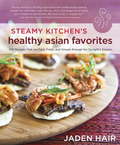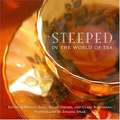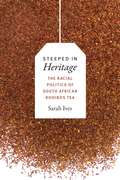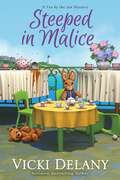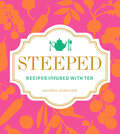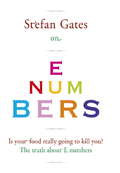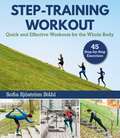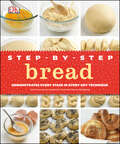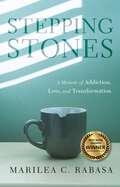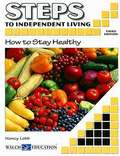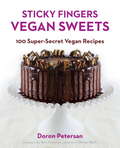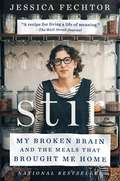- Table View
- List View
Steamy Kitchen's Healthy Asian Favorites
by Jaden HairSteamy Kitchen creator Jaden Hair, top Asian cooking blogger, gives a healthy and truly inspired overhaul to more than 120 classic Asian recipes, making them accessible and easy for home cooks.As the creator of the beloved blog Steamy Kitchen, Jaden Hair knows how to make Asian food accessible--and exciting--to home cooks. Now, with humor and a can-do attitude, Jaden presents this collection of her quick and flavorful recipes for healthy Asian dishes, most of which are naturally gluten-free and light on meat. With her infectious passion for cooking, Jaden teaches you how to shop for the best Asian ingredients, stock your pantry to streamline weeknight meals, and master delicious Asian cooking at home. Featuring good-enough-to-eat photography shot by Jaden herself, this book speaks to a new wave of healthy eaters without sacrificing flavor, ease, and fun. Jaden makes Asian foods seem approachable, not intimidating, and also offers new material for experienced Asian cooks looking to expand their repertoires. Doing away with gloppy sauces, oily stir-fries, and high calorie counts, these vibrant and unquestionably unique dishes are inspired makeovers of authentic dishes from China, Indonesia, Japan, Korea, Thailand, and Vietnam. Recipes such as Chicken-Mango Lettuce Cups, Seafood Curry Noodle Soup, Vietnamese Summer Rolls with Grilled Tofu, Korean Tacos My Way, and a Thai-inspired Peach and Basil Smoothie are perfectly suited for everything from casual dinners to impromptu parties and gatherings.Jaden's conversational style will make you feel as if you have a knowledgeable friend in the kitchen, guiding you through the process. With Jaden on your side, you can learn to cook fast, fresh, tasty Asian dishes that family and friends--from seasoned foodies to picky kids--will enjoy and request time and time again!
Steeped In Tradition: A Celebration of Tea
by Frances HoffmanFrom drawing rooms of Victorian Britain to Ontario kitchens, rituals of afternoon tea have always delighted. Devotees to this splendid ceremony attest to the fact that tasty treats and fresh brewed tea really do have a way of seducing and calming even the most frazzled of souls. And so, it is no accident that this deliciously elegant occasion continues to entice. Capture the essence of this splendid institution through the eyes of one who learned to sup the golden brew on her Granny’s lap. Enjoy recipes from Ontario’s finest Tea Rooms, in addition to those from a Lancashire family long steeped in the tea-time tradition. By looking at the ceremony of tea drinking and the history of "taking tea" in Ontario, one comes to understand why this great institution is still very much alive and flourishing.
Steeped In the World of Tea
by Sharon Bard Birgit Nielsen Clara RosemardaThroughout the world, tea has many uses and meanings. It is used in ritual, in healing, and in times of companionable sharing. This anthology brings together a wide assortment of writing in which tea is a central theme. Writers from places as diverse as India, Ireland, Argentina, and New York City reflect on the role of tea in their lives.
Steeped in Heritage: The Racial Politics of South African Rooibos Tea
by Sarah Fleming IvesSouth African rooibos tea is a commodity of contrasts. Renowned for its healing properties, the rooibos plant grows in a region defined by the violence of poverty, dispossession, and racism. And while rooibos is hailed as an ecologically indigenous commodity, it is farmed by people who struggle to express “authentic” belonging to the land: Afrikaners, who espouse a “white” African indigeneity, and “coloureds,” who are characterized either as the mixed-race progeny of “extinct” Bushmen or as possessing a false identity, indigenous to nowhere. In Steeped in Heritage Sarah Ives explores how these groups advance alternate claims of indigeneity based on the cultural ownership of an indigenous plant. This heritage-based struggle over rooibos shows how communities negotiate landscapes marked by racial dispossession within an ecosystem imperiled by climate change and precarious social relations in the postapartheid era.
Steeped in Malice (Tea by the Sea Mysteries #4)
by Vicki DelanyWith a &“beautifully described setting and a cast of charming, small-town characters&” (Booklist), this delightful cozy mystery series set in a Cape Cod tea shop will be irresistible for fans of Laura Childs&’ Tea Shop series. Afternoon tea isn&’t just about flavorful brews and delicious treats. It&’s also about presentation—fine china teacups (never mugs!), with carefully coordinated saucers and plates. With her fragile stock running low, Lily has an excuse to indulge in one of her favorite hobbies: visiting an antiques fair for replacements. Among other finds, Lily snaps up a charming Peter Rabbit-themed tea set in a wicker basket, perfect for children&’s events. But a few days later, a woman named Kimberly marches into the tearoom, rudely demanding to buy it back—then later returns and removes an envelope hidden in the basket&’s lining. An acquaintance of Lily&’s named Rachel is on the trail of the tea set too. Apparently, she and Kimberly are half-sisters, searching for their mother&’s final will. To her annoyance, Lily is dunked into the middle of this mess—especially when her ex-boyfriend turns out to be involved. But it&’s more than a storm in a teacup when one of the sisters is found dead on the grounds of the B&B owned by Lily&’s grandmother, Rose. Is this a simple case of greed boiling over, or are there other suspects in the blend? It&’ll take some savvy sleuthing from Lily, Rose, and their allies to find the answers before a killer shatters more lives . . .
Steeped in Secrets: A Magical Mystery (A Crystals & CuriosiTEAS Mystery #1)
by Lauren ElliottFrom the USA Today bestselling author of the Beyond the Page Bookstore Mysteries comes the first in a new series featuring an intuitive gemologist and owner of a New Age tea and crystals shop in beautiful coastal California&’s Monterey Peninsula. &“Appealing characters, surprising twists, a bit of magic, and the promise of romance. Lovers of paranormal cozies are sure to get on board.&” –Publishers Weekly Flat broke and divorced, intuitive gemologist Shay Myers has changed since leaving her artsy hometown of coastal Bray Harbor sixteen years ago. But when she moves back under strange circumstances, old instincts may be the only key to spilling the tea on a deadly mystery. Even with her life in ruins in New Mexico, Shay feels uneasy about settling into the small seaside town where she grew up on California&’s Monterey Peninsula and taking over an estate bequeathed to her by Bridget Early, a woman she had barely known. Her heightened senses—an empathic gift she&’s had since childhood—go into overdrive upon touring Crystals & CuriosiTEAS, Bridget&’s eclectic tea and psychic shop brimming with Irish lore and Celtic symbols. They reach a boiling point when Shay looks up to discover a stranger&’s body sprawled across the shop&’s greenhouse roof . . . With her new business a crime scene and questions brewing over Bridget&’s so-called accidental death, Shay fears she&’s also inherited the attention of a killer. The terrifying realization sets her on an impractical investigation for answers aided by her sister, an elusive pure-white German Shepherd, a strikingly handsome pub owner who speaks in a gentle brogue, and a misunderstood young woman with perceptive talents of her own. As Shay struggles to figure out her true purpose in Bray Harbor and the powerful connection she has with the tea shop, she must trust her judgment above all else to identify a ruthless murderer and save herself from becoming victim number three.
Steeped: Recipes Infused with Tea
by Annelies ZijderveldA Los Angeles Times Favorite Cookbook of the Year. From morning eats to evening sweets, Steeped infuses your day with the flavors and fragrances of tea. Romance your oat porridge with rooibos, jazz up your brussels sprouts with jasmine, charge your horchata with masala chai! Annelies Zijderveld&’s deliciously inventive tea-steeped recipes include: Matcha Chia Pudding ParfaitsEarl Grey Soba Noodle SaladGreen Tea Coconut RiceChamomile Buttermilk Pudding with Caramelized BananaEarl Grey Poached Pears with Masala Chai Caramel Sauce This beautiful book will inspire you to pull out your favorite teas, fire up the stove, and get steeping!&“Part tea primer but also intrepid tea explorer . . . This book would make a great gift for both tea newcomers and those who can rhapsodize about the smoky complexities of a Lapsang souchong.&” —Los Angeles Times&“Steeped is smart, inventive, and most of all, inspiring. This beautiful book deserves a spot next to your teacup.&” —Molly Wizenberg, author of A Homemade Life&“The first few pages are a wonderful primer describing each tea&’s history and flavor profile. The photos are lovely and the 70 all-vegetarian recipes are easy to follow.&” —Marin Independent Journal&“Cooking with tea is like discovering another whole shelf of spices. Thankfully we now have Annelies to show us how.&” —James Norwood Pratt, author of The Ultimate Tea Lover&’s Treasury
Steeped: Recipes Infused with Tea
by Annelies ZijderveldA Los Angeles Times Favorite Cookbook of the Year. From morning eats to evening sweets, Steeped infuses your day with the flavors and fragrances of tea. Romance your oat porridge with rooibos, jazz up your brussels sprouts with jasmine, charge your horchata with masala chai! Annelies Zijderveld&’s deliciously inventive tea-steeped recipes include: Matcha Chia Pudding ParfaitsEarl Grey Soba Noodle SaladGreen Tea Coconut RiceChamomile Buttermilk Pudding with Caramelized BananaEarl Grey Poached Pears with Masala Chai Caramel Sauce This beautiful book will inspire you to pull out your favorite teas, fire up the stove, and get steeping!&“Part tea primer but also intrepid tea explorer . . . This book would make a great gift for both tea newcomers and those who can rhapsodize about the smoky complexities of a Lapsang souchong.&” —Los Angeles Times&“Steeped is smart, inventive, and most of all, inspiring. This beautiful book deserves a spot next to your teacup.&” —Molly Wizenberg, author of A Homemade Life&“The first few pages are a wonderful primer describing each tea&’s history and flavor profile. The photos are lovely and the 70 all-vegetarian recipes are easy to follow.&” —Marin Independent Journal&“Cooking with tea is like discovering another whole shelf of spices. Thankfully we now have Annelies to show us how.&” —James Norwood Pratt, author of The Ultimate Tea Lover&’s Treasury
Stef Soto, Taco Queen (Penworthy Picks Middle School Ser.)
by Jennifer Torres<p>A heartwarming and charming debut novel about family, friends, and finding your voice all wrapped up in a warm tortilla. <p>Estefania "Stef" Soto is itching to shake off the onion-and-cilantro embrace of Tia Perla, her family's taco truck. She wants nothing more than for Papi to get a normal job and for Tia Perla to be a distant memory. Then maybe everyone at school will stop seeing her as the Taco Queen. <p>But when her family's livelihood is threatened, and it looks like her wish will finally come true, Stef surprises everyone (including herself) by becoming the truck's unlikely champion. In this fun and heartfelt novel, Stef will discover what matters most and ultimately embrace an identity that even includes old Tia Perla.</p>
Stefan Gates on E Numbers
by Stefan Gates'Stefan Gates on E Numbers' is a myth-busting celebration of 'E's--the additives and preservatives that make up Britain's most feared ingredients. Most of the food we eat has them yet we are hugely suspicious of them and believe that they cause everything from twitchy eyelids to colon cancer. In this book Stefan discusses just how bad our food would taste, how wrong it would look and how potentially lethal it would be if we didn't have E numbers. You may not realize that many of the finest foods on the planet (including caviar, fine hams and wines) rely on E's. And if you think nature is good and Es are bad, you'd be wrong: the natural world is awash with dangerous toxins (apples contain cyanide, potatoes contain toxic solanine), yet E number substances make up 99.99% of every breath you take. Stefan analyzes all 319 Es approved for use in food and also talks about labelling issues (how to understand them), how much you can safely eat and what, if anything, is wrong with cheap food. He also investigates the scare stories, allergies and potential downsides of the multi-billion pound food industry. If you don't like Es you don't have to eat them but you should make that choice based on facs not fear. Without E numbers we would not have supermarkets. Without this book you cannot make an informed decision about what you are buying and eating.
Step-Training Workout: Quick and Effective Workouts for the Whole Body
by Sofia StahlUsing a staircase, you can now easily do short intensive, interval training using only your own body weight. Give your body exactly what it needs—plenty of strength and conditioning—but without taking too much time out of your busy day or spending loads of money on a gym.Learn to utilize the staircases in your everyday environment and maximize every step with this practical guide. Step-Training Workout contains sixty exercises along with suggestions on structuring your workouts into time-saving and utility-boosting intervals. Each exercise typically takes between 5 and 15 minutes and can be done on-the-go, on a lunch a break, or at home after a long day—perfect for anyone who can’t fit in a full workout. Whether you’re just starting out or are an avid exercise, this book will add new, incredible workouts to your repertoire. With Step-Training Workout, learn how to get fit fast and feel great! <p>
Step-by-Step Bread: Demonstrates Every Stage in Every Key Technique
by DKIf you want success in the kitchen, DK's new Step-by-Step Series will take you through every single stage of classic recipes with clear, illustrated, step-by-step instructions that guarantee you will be cooking with confidence. Presenting two hundred recipes in clear, step-by-step sequences — with every single stage demonstrated — Step-by-Step Bread covers Classic Breads and Artisan Breads, Flat Breads and Crisps, Quick Breads and Batters, as well as Sweet Breads. Step-by-Step Bread is packed with clear instructions, essential information on ingredients, special equipment and storage, and the world's favorite recipes.
Step-by-Step Cake Decorating: Hundreds of Ideas, Techniques, and Projects for Creative Cake Designers
by Karen SullivanFrom delicate creations for weddings to fantastical birthday cupcakes, Step-by-Step Cake Decorating contains 20 remarkable projects for every occasion. There are more than 100 pages of step-by-step icing, piping, stenciling, painting, and cutting techniques. Each cake recipe includes fun, unique tips and variations for turning it into cupcakes and cake pops. Home bakers looking to impress their friends and family with gorgeous confections will love these smart, elegant projects.
Step-by-Step Delicious: Learn to Cook Your Favorite Dishes in 7 Steps or Less
by Catrine KeltyEveryone these days loves the fast-paced, overhead-view cooking videos that appear online and are shared millions of times each day on social media. Food writer Catrine Kelty and photographer Adam DeTour sure do, and together they have created this picture-filled cookbook for their fellow fans—to enjoy, to cook from, or to give as a gift. It’s the perfect book for a visually savvy teen or young adult who’s learning how to cook, and it’s a fantastic resource and companion for cooks of any age who want to up their kitchen game. Each of the book’s 100 recipes has at least 4 step-by-step photographs, making this a new kind of cookbook for the online generation. The book has loads of ideas for recipes that help kitchen newbies learn how to cook and ones that give more-experienced cooks new things to try. It includes easy-to-make grab-and-go breakfasts and lunches, along with nutritious-but-delicious snacks that give you extra energy for after school or after work. There are quick-to-fix dinners for the weekday whirl, plus fancy dinners, as well as awesome party foods, for casual weekends with friends. Not least, there are lots of recipes for sweet things—luxurious cookies, cakes, brownies, blondies, pies, tarts, and more—for readers who want to learn how to bake delicious treats and desserts with ease.
Stepping Stones: A Memoir of Addiction, Loss, and Transformation
by Marilea C. RabasaAddiction is a stealth predator. Unrecognized, it will grow and flourish. Unchecked, it destroys.Marilea Rabasa grew up in post-WWII Massachusetts in a family that lived comfortably and offered her every advantage. But they were also haunted by closely guarded family secrets. Alcoholism reached back through several generations, and it was not openly discussed. Shame and stigma perpetuated the silence. And Marilea became part of this ongoing tragedy.From an unhappy childhood to a life overseas in the diplomatic service to now, living on an island in Puget Sound, Stepping Stones chronicles Marilea&’s experiences, weaving a compelling tale of travel, motherhood, addiction, and heartbreaking loss. The constant thread throughout this story is the many faces and forms of addiction, phantoms that stalk her like an obsessed lover. What, if anything, will free her of the masks she has worn all her life? An inspiring, poignant recovery story, Stepping Stones tells how Marilea took on the demons that plagued her all her life—and defeated them.
Steps to Independent Living: How to Stay Healthy (Third Edition)
by Nancy LobbHow to Stay Healthy focuses on developing good grooming habits, taking care of one's body, practicing good nutrition (based on the Food Pyramid), and staying fit. It shows students how to take care of themselves and face the challenges of everyday living. Explains essential tasks and responsibilities at a manageable reading level, with demonstrations, activities, illustrations, self-tests and comprehension checks throughout the text.
Steve the Bartender's Cocktail Guide: Tools - Techniques - Recipes
by Steven RoennfeldtCraft delightful drinks at home and impress your guests with your newfound bartending expertise!Explore the realm of timeless favorites and forgotten classics in this all-encompassing guide by Steve the Bartender, YouTube's beloved Australian bartender. Discover the simplicity and flair of crafting cocktails with ease, guided by approachable and unpretentious instructions that guarantee each drink to be both straightforward and delicious.What you'll find in this guide: Guidance on setting up a home bar, complete with essential spirits, mixing equipment, and glassware.A curated collection of 125 drink recipes for every occasion, from a sophisticated Manhattan to a refreshing Mai Tai, all accompanied by beautiful photographs. Integrated QR codes for each recipe linking directly to videos of Steve demonstrating the preparation of each drink.Join Steve on a journey to master the world of cocktails—whether you're a seasoned enthusiast or a complete novice, this guide will become your ultimate companion in creating the perfect libations. Cheers to the world of effortless cocktails!
Stewards of Eden: What Scripture Says About the Environment and Why It Matters
by Sandra L. RichterSandra L. Richter cares about the Bible. She also cares about creation.
Sticks and Scones: A Bakeshop Mystery (A Bakeshop Mystery #19)
by Ellie AlexanderAnother delicious installment in the Bakeshop Series set in Ashland, OR!It’s late spring in Juliet's charming hamlet of Ashland. Spotted deer are nibbling on lush green grasses in Lithia Park, the Japanese maples are blooming, and Torte is baking a bevy of spring delights—lemon curd cupcakes, mini coconut cream pies, grapefruit tartlets, and chocolate dipped almond Tuiles.Meanwhile, Juliet's friend Lance, the artistic director of the Oregon Shakespeare Festival, is taking center stage with his new theater troupe—the Fair Verona Players. Their performance in Uva's vineyard promises to be a modern, gender-bending twist on "The Taming of the Shrew," but as the curtain rises, so do the strange occurrences. Stage mishaps and internal bickering threaten to derail the production. But the real show begins when the leading actor, Jimmy Paxton, meets his final curtain call. Now, Jules is not only in the mix, but she's going to need to craft the perfect recipe for solving this theatrical whodunit.
Sticky Fingers' Sweets
by Doron PetersanA Food Network Cupcake Wars winner shares her scrumptious recipes in a new cookbook that has vegans and omnivores alike clamoring for more. When Sticky Fingers Sweets & Eats opened in 2002, it instantly became one of the most popular bakeries in D.C.-a bakery that just happens to be vegan. Soon, Sticky Fingers was voted D.C.'s best bakery by The Washington City Paper, and chef Doron Petersan found herself beating out traditional bakers on the Food Network's Cupcake Wars.Sticky Fingers' Sweets is packed with one hundred of her beloved recipes- from indulgent snacks like Fudgetastic Brownies and Oatmeal Raisin Cookies to breakfast treats like Pecan Spice Coffee Cake and Cranberry Ginger Scones, and from celebratory desserts like Chocolate Seltzer Cake and Red Velvet Cupcakes to Sticky Fingers' most popular sweets- Little Devils, Cowvins, and Sticky Buns. Petersan also includes "love bite" nutritional tips and valuable tricks-of-the- trade techniques that every home baker will appreciate.The number of people embracing a vegan lifestyle continues to grow. Like Erin McKenna's BabyCakes and Isa Chandra Moskowitz's bestselling cookbooks, Sticky Fingers' Sweets and Petersan's delectable-and secretly healthy-recipes will be greeted enthusiastically by anyone and everyone who loves to bake.
Sticky, Chewy, Messy, Gooey Treats for Kids
by Jill O'ConnorThirty deliciously sweet treats for kids that they can help make, including cookies, cupcakes, biscuits, fruit crisps, and ice cream treats.Teeny tummies love yummy treats. is bursting with thirty tasty but simple recipes for sticky sweets and gooey breakfasts. Such delights as Pinkalicious Princess Cupcakes, Wicked Good–Chocolate Peanut Butter Pudding Cups, Banana Split Pancakes, and Hunka Chunka Chewy Chocolate Chip Cookies are the kinds of treats kids will love. With step-by-step instructions, this book gets the whole family gathered around the mixing bowl.
Sticky, Chewy, Messy, Gooey: Desserts for the Serious Sweet Tooth
by Jill O'ConnorA collection of dessert recipes that gives you more than seventy-five delicious reasons to stock up on napkins.Chocolate Caramel-Pecan Soufflé CakeCinnamon-Donut Bread PuddingChewy Lemon-Pistachio FinanciersDouble-Crumble Hot Apple PiesButterscotch-Bourbon Macadamia Nut PieStill not satisfied? How about Cheesecake Pops, Giant Coconut Cream Puffs, Hawaiian Caramel Corn, Milky Way Tempura-on-a-Stick, or Sticky Pear and Walnut Upside-Down Gingerbread? And there are plenty more where that came from.In addition to each buttery, sugary favorite, author Jill O’Connor has included all the techniques and tools you’ll need to re-create these perfectly decadent treasures. Sprinkled throughout are sweet tips on using phyllo dough, toasting nuts, choosing the right cocoa, and making a heavenly ganache, ensuring that every pudding, cookie, cake, pie, and over-the-top treat tastes as irresistible as it sounds.If you think chocolate, marshmallow, whipped cream, and caramel belong in a separate food group all their own, you’re ready to bite into all that’s Sticky, Chewy, Messy, Gooey.
Still Beautiful: On Age, Beauty and Owning Your Space
by Katie PiperAge is a gift not everybody is given…'A beautifully thoughtful, considered and candid read. As always, Katie&’s trademark warmth and grace shines through' - Stacey Dooley, TV presenter and authorWhen a life-threatening acid-attack left Katie Piper physically and visibly scarred at just 24, her approach to ageing was irrevocably changed: she now sees each passing year as a reminder of the privilege of being alive.Over a decade on from sharing her story for the first time, Katie reflects on what it means to age well within a world that has too often made women feel irrelevant or invisible for going through the natural ageing process.From how to know your worth to how to take up space in a society that tells you to be small, this book will help you cultivate a confidence you can depend on and find the real beauty in getting older.Katie Piper OBE is an international bestselling author, inspirational speaker, TV presenter and charity campaigner. She is a regular panelist on ITV&’s Loose Women and a presenter for BBC Radio 2. Katie shared her remarkable story in a Channel 4 documentary called &‘Katie: My Beautiful Face&’, which was watched by over 3.5 million viewers and nominated for a BAFTA in 2010.
Still We Rise: A Love Letter to the Southern Biscuit with Over 70 Sweet and Savory Recipes
by Erika CouncilA love letter to the Southern biscuit, honoring its place in Black culinary culture and beyond with over 70 delicious recipes.Still We Rise is a tribute to the glories of flour, butter, and buttermilk baked tall, tender, and flaky. Erika Council is the founder and head baker of the renowned Bomb Biscuit Company in Atlanta, Georgia. The granddaughter of legendary soul food chef Mildred (Mama Dip) Council and a teacher and activist who cooked and baked to support the civil rights movement, Erika knows all about the power of the persistent biscuit.Here, Erika has perfected traditional biscuit types alongside inventive new creations. Her recipes connect readers to stories of the family, friends, and Southern culinary icons who instilled in her a love of baking.Through over 70 unique recipes for biscuits, spreads, sandwiches, and a convenient home biscuit mix that will have you whipping up fluffy biscuits and bis-cakes in minutes, Erika takes us on a journey through Black excellence, resilience, and heritage in the American South. Step into her world and enjoy her classic Bomb Buttermilk Biscuit, the lightest Angel Biscuits, and new favorites like Corn Milk Biscuits, Everything &“Bagel&” Biscuits, Hominy Honey Butter, and the Glori-Fried Chicken Biscuit Sandwich, (plus a mind-blowing Cinnamon Sugar and Pecan Biscuit).
Stir
by Jessica FechtorAn exquisite memoir about how food connects us to ourselves, our lives, and each other. At 28, Jessica Fechtor was happily immersed in graduate school and her young marriage, and thinking about starting a family. Then one day, she went for a run and an aneurysm burst in her brain. She nearly died. She lost her sense of smell, the sight in her left eye, and was forced to the sidelines of the life she loved.Jessica's journey to recovery began in the kitchen as soon as she was able to stand at the stovetop and stir. There, she drew strength from the restorative power of cooking and baking. Written with intelligence, humor, and warmth, Stir is a heartfelt examination of what it means to nourish and be nourished. Woven throughout the narrative are 27 recipes for dishes that comfort and delight. For readers of M.F.K.Fisher, Molly Wizenberg, and Tamar Adler, as well as Oliver Sacks, Jill Bolte Taylor, and Susannah Cahalan, Stir is sure to inspire, and send you straight to the kitchen.From the Hardcover edition.
